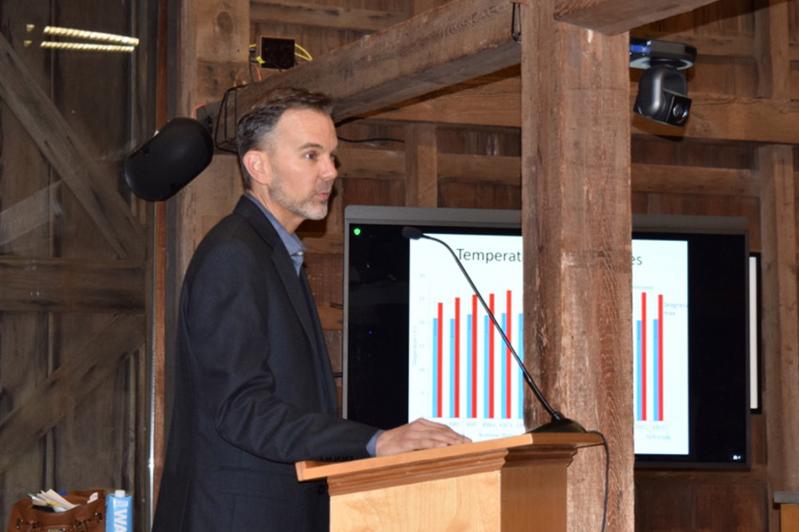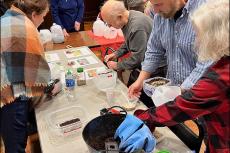Most waters under East Hampton Town Trustee jurisdiction were usually healthy in 2022, the trustees were told on Monday, but the consequences of land use continue to impair some water bodies in the form of excessive nitrogen via ground and surface water runoff.
As in years past, harmful algal blooms and pathogens were present at concerning levels in some water bodies, though mitigation efforts have proven effective at Georgica Pond, once one of the most ecologically compromised in the town.
Christopher Gobler of Stony Brook University’s School of Marine and Atmospheric Sciences, noting that 2022 was the 10th consecutive year in which his lab has conducted water quality testing for the trustees, delivered another mostly upbeat presentation, an annual event that provides increasingly granular data on water conditions and the causes behind them.
Testing was conducted between May and October to assess water quality, harmful algal blooms, pathogenic bacteria, and sediments. Sixteen marine sites within Napeague Harbor, Accabonac Harbor, Hog Creek, Three Mile Harbor, Northwest Creek, and Little Northwest Creek were sampled on a biweekly basis, as were eight freshwater sites, on a weekly basis, within Fresh Pond, Georgica Pond, Hook Pond, Wainscott Pond, and Fort Pond. (Sampling of the latter was performed by Concerned Citizens of Montauk, with samples delivered to a lab for processing.)
Continuous monitoring and/or surface mapping of Three Mile Harbor, Napeague Harbor, Accabonac Harbor, and Georgica Pond was also done because of past instances of harmful algal blooms and/or low dissolved oxygen at those sites. The latter part of the summer also saw the maiden voyage of a HYCAT autonomous surface vehicle for monitoring of Accabonac, Napeague, and Three Mile Harbors.
Wainscott Pond, which is not accessible to the public, continues to earn the dubious distinction of most compromised among the water bodies studied by Dr. Gobler and his team. There, toxic cyanobacteria, or blue-green algae, were present at an order of magnitude above the D.E.C.’s bloom threshold almost continuously throughout the sample period. That threshold was also briefly surpassed in Hook Pond and Fort Pond.
The use of an aquatic weed harvester at Georgica Pond, which had experienced the worst cyanobacteria blooms on Long Island in 2014 and 2015, has been fruitful, Dr. Gobler said. Last year, 72,000 pounds of pondweeds and macroalgae were removed, “a significant bioextraction approach,” he said. Since the harvester was put into use, from 2016 through 2018 and from 2020 through last year, cyanobacteria have not gotten “even close to where it was before,” he said.
Nitrogen concentrations exceeded the Peconic Estuary threshold at sites in Hog Creek, Accabonac Harbor, and at one sample site in Three Mile Harbor. Chlorophyll a concentrations trend with those of nitrogen, Dr. Gobler told the trustees. Although generally below the National Oceanic and Atmospheric Administration maximum, concentrations exceeded that threshold at Napeague, Accabonac, and Three Mile Harbors as well as in Hog and Northwest Creeks, and were well above the federal Environmental Protection Agency’s maximum at Georgica, Hook, and Fort Ponds, and, especially, Wainscott Pond.
Alexandrium, which produces a neurotoxin that can lead to closure of shellfish beds, was detected at the head of Three Mile Harbor, but not at excessively high levels, with the exception of one location on one day. It was more widespread and consistent in Accabonac Harbor, Dr. Gobler said.
Rust tide, caused by Cochlodinium blooms, which he described as “probably the most intense of the harmful algal blooms we see in East Hampton waters,” was first seen in Suffolk County in 2004. It was detected only at very low levels in 2022. “Hopefully, this is the start of a good trend.”
At various times over the summer and early fall, fecal coliform bacteria levels greatly exceeded the New York State Health Department maximum for shellfishing at most survey sites in Accabonac and Three Mile Harbors. Levels of enterococcus also exceeded the Health Department maximum at sites in both water bodies.
Measurements of dissolved oxygen in Three Mile Harbor, which are higher in the daytime when photosynthesis is occurring, often fell below the Department of Environmental Conservation minimum.
Citing the apparent success of the aquatic weed harvester in Georgica Pond, Dr. Gobler said bioextraction on a mass scale could benefit other water bodies. Cultivation of seaweeds such as sugar kelp and farming of bivalves such as oysters are also methods of bioextraction, he said. The use of kelp at oyster grow sites, for example, can increase dissolved oxygen and deter harmful algal blooms.
Dredging, he added, can also improve water quality by removing sediment and improving water circulation and tidal flushing.




